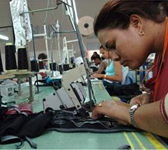A US$4 million fund set up by the Colombian government in January drove home the degree to which the country's textile and apparel industry has been hammered by illegal imports. The money is not earmarked for scholarships, technology incentives or tax breaks, but for rewards to tipsters who lead investigators to clothing and fabric smugglers.
The fund was unveiled with little fanfare during Colombiatex, the annual exhibition in Medellin for the nation's thread, fabric and clothing makers to show off their wares to foreign buyers. It was, nonetheless, welcome news at an otherwise somber event, with one exhibitor after another grousing about their struggles to compete against Asian textile and apparel imports, nearly half of which are thought to be contraband or brand rip-offs that often sell at a fraction of the price of comparable Colombian goods. The bulk of those illegal goods are said to be from China, according to ANDI, the country's top business association.
Though a big factor, the Asia threat isn't all that's thrown Colombia's textile sector off course, however. Paula Trujillo, competitiveness director of InExModa, an industry trade association that sponsors Colombiatex, says Colombia's industry also has itself to blame, having grown complacent under the protection of an international quota system and a favorable U.S. dollar-Colombian peso exchange regime, and having invested too little in new technology and markets. "We were not walking at the same velocity and agility as some other countries," she says. "We lost the drive and now have to reinvent ourselves."
The upshot of all those forces has been painful. Domestic fabric and apparel sales have stagnated at about US$5 billion annually in recent years, even as overall economic growth has been robust. More worrisome is that textile and apparel exports fell 45% to US$1.1 billion last year from US$2 billion in 2008, according to Carlos Eduardo Botero, executive director of InExModa. Few firms have been left unscathed — even Coltejer, an iconic manufacturer and namesake of Medellin's tallest building, has skirted bankruptcy in recent years and is trying furiously to retrench. Workers, too, are paying a high price — Colombia's fabric and clothing industry has lost 35,000 jobs, or 15% of the total, over the last two years, according to ANDI.
'A Very Depressing Decade'
Can Colombia's troubled textile and apparel industry get its groove back after what Alvaro Hincapie, president of Medellin-based Enka, Colombia's largest thread manufacturer, calls "a very depressing decade"? Like many in his industry, Hincapie says his company has been "under attack" by Asian firms legally or illegally squeezing Enka out of markets with their cheaper goods.
Founded in 1966, when several Colombian companies joined forces with a local unit of Dutch-based Akzo Nobel, Enka has had first-hand experience of many of the ups and downs of the sector's globalization. By the early 1990s, it was the leading manufacturer in the Andean region of nylon and other polyester threads, a star in a constellation of successful Colombian textile and apparel companies, most of which were based in Medellin. Helped then by both the country's weak peso and an innovative resin manufacturing process, Enka thrived under the Agreement on Textiles and Clothing, an arrangement that governed world trade in textiles and clothing from 1974 to 2004 by enacting quotas on the amount developing countries could export to developed ones. During that time, Enka also began exporting to a range of new markets, from the U.S. to Brazil, while also supplying local manufacturers.
But the company's fortunes began to change, partly but not solely because of the end in 2005 of the quota system that had long given companies like Enka unfettered access to U.S. and European markets. By 2008, Colombia was flooded with polyester threads and fabrics from Southeast Asia that sold for one third of Enka's cost, Hincapie recalls. Some of the materials came in illegally; some with all the required customs documentation. The nadir was in 2008 when Enka suffered a 40% loss of sales and was forced to discontinue several polyester lines. By the end of that year, the company had shed 1,000 employees, or 15% of its work force.
According to Hincapie, it was China's manufacturers, in particular, that were behind the changing forces. "The Chinese took advantage of lapsing polyester patents and low labor costs to produce these goods in huge quantities. Government subsidies enabled them to install much more manufacturing capacity than they needed to supply the Chinese market. So what they couldn't sell, they dumped on the international market at a fraction of their cost."
Bursting Onto the Scene
Trade experts cite China's admission to the World Trade Organization in 2001 as the turning point. In 2000, China was exporting 7% of the world's manufactured goods, and now accounts for 20% of all such exports. Textiles and apparel are among the industrial sectors most affected, notes Gary Hufbauer, a trade specialist at the Peterson Institute for International Economics in Washington, D.C. and a former U.S. Treasury Department trade negotiator. "No one who was involved in the Uruguay Round [of multilateral trade negotiations] concluded in 1995m [which] set terms for China's WTO entry, expected that China would burst onto the textiles and clothing scene as they have," he says. "It's beyond anyone's expectations and the rules haven't caught up to it yet."
As Hufbauer points out, China is running a global trade surplus of close to $300 billion annually, up from $20 billion a decade ago. "Colombia is feeling the pinch. But it has a lot of company," he says.
Changing trade winds isn't the only reason for the erosion of Latin America's overall manufacturing competitiveness, according to Marshall Fisher, a Wharton professor of operations and information management. When it comes to wooing global manufacturers in search of low-cost production sites, Latin American countries face stiff competition from not only China, but also other Asian emerging markets, he notes. Fisher cites recent research from the Institute for Global Labor and Human Rights showing that hourly minimum wages in the garment industry in a number of Asian countries, such as Bangladesh, Indonesia and Vietnam, range between 21 U.S. cents and 71 U.S. cents, as much as one-third lower than many Latin American countries, and even lower than the rate in China, whose hourly wage is around US$1. In Colombia, the average hourly minimum wage for garment workers is US$1.17. What's more, the garment industry elsewhere in Asia, such as the Philippines — where the hourly minimum wage in the sector is around 94 U.S. cents — has other attractions, such as an English literacy rate of 92.6%, low employee turnover and long-term tax incentives. Fisher says some manufacturers he has interviewed also cited a stronger work ethic in Asia than in Latin America as another attraction.
The long-term effects of Latin America's loss of manufacturing output and jobs may turn out to be far more serious from a development standpoint than short-term trade imbalances, notes Ariel Armony, director of the Center for Latin American Studies at the University of Miami. The loss, he says, of the "competitive edge" in manufacturing increases Latin American countries' reliance on the export of natural resources and commodities to even up their trade balances. But favoring commodities robs an economy of the beneficial educational, technological and job "multiplier effect" that manufacturing creates, according to Armony.
"Latin America could be pushed into a development strategy that is a reversion to something resembling its 19th century reliance on agricultural exports," says Armony. "That's an anachronistic model because the incentive should be to diversify into high technology and innovation."
Friends and Foes
The threats looming over Colombia's textiles and apparel industry are close to home in more ways than one. It has lost the lion's share of its most important export market — Venezuela — following a diplomatic spat last year between the presidents of the two countries. In retribution, Venezuelan President Hugo Chavez closed his country's border to most Colombian imports and froze US$800 million of payments owed by Venezuelan companies to Colombian suppliers, about a quarter of which are owed to textile and apparel companies. Although Colombia's new president, Juan Manuel Santos, is seeking to improve ties with its volatile neighbor, trade remains virtually frozen and the debts unpaid.
The wave of Asian contraband is also a product of Colombian money laundering, which goes hand in hand with the South American country's multibillion-dollar cocaine business. To repatriate drug profits, Colombian traffickers buy merchandise in Asia, which they ship it back home. Once in Colombia, they sell the goods at steep discounts, an acceptable cost in a high margin business. The practice is aided and abetted by corrupt port officials in Colombia and lax supervision at Panama's free trade zone in Colon, through which much of the contraband passes. The University of Miami's Armony says two-thirds of certain goods imported into Colombia, including textiles as well as luggage, perfume, liquor and shoes, may be falsely branded or smuggled.
But there is hope for Colombia's textiles and clothing sector, Armony notes, thanks in large part to a renewed focus on innovation. "It's good to see that some recognize it's not all China's fault, and that discussion in Colombia is also focusing on design, creativity and finding niches."
Some Colombian companies are focusing on specialized lines and taking advantage of being closer geographically to U.S. and European markets than China. Crystal Group, a vertically integrated Medellin-based "bale-to–retail" firm, is leveraging the increasing spending power of Latin Americans to expand its high-end Punto Blanco lingerie chain in several countries, including Chile and Peru. And, despite its currency disadvantage — the strengthening of the peso against the dollar has Colombian goods up to 30% more expensive for the U.S. consumers since 2006 — the company hasn't given up on the U.S. apparel market, and is exporting youth-oriented sports clothing to Target, Macy's and others. One reason for Crystal's continued focus on those markets is its "quick response" advantage over Asia, according to Luis Fernando Restrepo, Crystal's president. He claims the company can deliver major orders to U.S. retailers in 15 days or less, or one third the typical delivery time necessary for orders placed with Chinese suppliers.
Another advantage, he notes, is that Crystal has learned to play to its strengths. "We are now a brand-oriented company that sells products with a story," Restrepo says. "We no longer try to just push out commodity products in high volumes. China will eat you alive in that business."
Back in Vogue
Then there's Enka. In a bid to survive, it launched a strategic review, which explored developing 100 different new products, the result of which turned out to be the star of this year's Colombiatex: A denim material comprised of 32% synthetic threads made from recycled plastic bottles and 68% cotton, which Enka manufactures as part of a joint venture with another Medellin-based firm, Fabricato.
Made with recycled polyethylene terephthalate (PET) — plastic bottles that are crushed and converted into synthetic thread — the cloth has the comfortable, downy feel of old blue jeans. Enka invested US$36 million to set up a nationwide recycling network in 19 cities and to buy machinery before the launch. The upholstery sector is also a big potential market for the new fabric, Enka's Hincapie adds.
According to Fabricato's president, Oscar Zuluaga, the joint venture recently made its first sale — a US$160,000 deal with jeans maker Werner-Eickelmann of Germany. The company is first focusing on Europe because of its established market for recycled fabrics, but will soon be pitching San Francisco-based Levi's, which already buys denim products from Fabricato.
"People don't just like the product; they like what it does, which is recycle bottles that otherwise would take 100 years to degrade," Zuluaga notes. While the fabric costs 10% more to make than all-cotton denim, he says eco-conscious consumers don't balk at the higher prices.
Because this year's theme at Colombiatex was "Nature into Technology," Enka's "EkoDenim" fit right in. Many exhibitors showcased new products featuring natural, native or recycled threads and fabrics as part of a new "green" emphasis on fabrics and clothing to appeal to the environmentally conscious.
Enka's Hincapie says the company is on the road to recovery, adding that by this spring, all 1,000 jobs the company had to eliminate earlier this decade will have been replaced, thanks in part to the market success of its new Eko thread product made from recycled bottles.
The company is now recycling one million bottles a day and producing 800 tons of synthetic thread from the materials each month. This spring, it will open a second recycling plant. Hincapie says the crisis of recent years has helped shape a new company with "social commitment and environmental consciousness."
"Recycling is the foundation of our long-term strategy," Hincapie notes. "It's opened up an entirely new portfolio of products for us."



